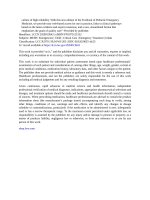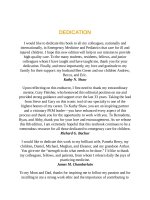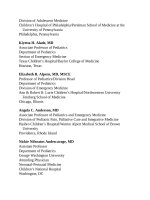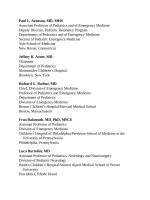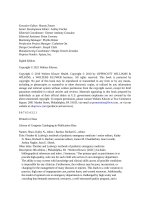Pediatric emergency medicine trisk 0825 0825
Bạn đang xem bản rút gọn của tài liệu. Xem và tải ngay bản đầy đủ của tài liệu tại đây (71.34 KB, 1 trang )
type of impact surface, and type and velocity of striking objects. Occurrence of
LOC as well as duration should be determined. If the event was unwitnessed and
the patient is amnestic, the clinician should assume that LOC occurred.
Occurrence of seizure activity (including details of time of onset posttrauma,
duration, and focality) and the child’s level of alertness since the injury should be
noted, as well as presence of vomiting, irritability, ataxia, and abnormal behavior
—all signs of possible brain injury. Vomiting after a head injury is not
uncommon; however, persistence for more than several hours may signal
intracranial abnormalities. If the child is verbal, he or she should be questioned
about the presence of headache or neck pain, amnesia, weakness, visual
disturbances, or paresthesias. In many cases, elicited symptoms may be the only
evidence of underlying CNS injury. In infants, symptoms of TBI may be subtle or
absent; therefore, the clinician should pay particular attention to any alteration in
behavior in this age group. Progression or resolution of any symptoms,
neurologic signs, and level of consciousness since the traumatic episode must be
defined clearly. One should also inquire about previous medical history and
factors predisposing to head trauma (e.g., seizure disorder, gait disturbance,
bleeding diathesis, alcohol abuse, or illicit drug use). When there are
discrepancies in the history, when the history does not fit the physical findings, or
when there is a skull fracture or TBI in a young child without a history of
significant trauma, one should suspect nonaccidental injury.
Physical Examination
After a primary survey with appropriate resuscitation, a thorough physical
examination should be performed, with special emphasis on the vital signs, head
and neck, and neurologic examination. Bradycardia may be a sign of increased
ICP; it is of particular concern when associated with hypertension, abnormal
breathing pattern, depressed level of consciousness, or neurologic abnormality.
Bradycardia may also be seen with spinal cord injuries caused by unopposed
parasympathetic tone; in this case, it is often associated with hypotension,
flaccidity, a sensory level, and absent deep tendon reflexes. Tachycardia may
reflect hypovolemia (especially if associated with hypotension), hypoxia, pain, or
anxiety. Isolated head injuries rarely cause hypovolemia (except in infants with
large subgaleal or intracranial hematomas); therefore, hypotension should alert
the clinician to a possible extracranial or spinal cord injury.
The head should be inspected and palpated carefully for scalp swelling,
lacerations, irregularities of the underlying bony structure, and fontanel fullness
(in infants). Signs of basilar skull fracture (periorbital or postauricular
hemorrhage in the absence of direct trauma, hemotympanum, CSF otorrhea, or
